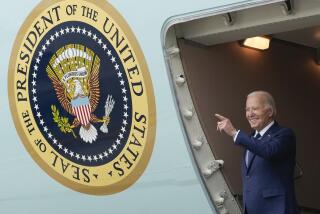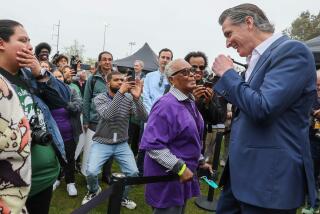Spirit May Be Guiding, but Politicking Is Strong
VATICAN CITY — Cardinals gathering to choose the next pope like to say they are guided by the Holy Spirit. But the Lord moves in mysterious ways, and his delegates can be real wheeler-dealers.
Pope John Paul II forbade overt politicking and behind-the-scenes horse-trading in the coming days. The cardinals, he wrote in the 1996 constitution that lays down the rules, “shall abstain from any form of pact, agreement, promise or commitment of any kind which could oblige them to give or deny their vote to a person or persons.” But he did allow the “exchange of views” in the period between a pope’s death and the moment the cardinals sequester themselves in the Sistine Chapel.
By the time they sit down to business April 18 under Michelangelo’s imposing “Last Judgment,” the cardinals will have conferred, cajoled, pondered and probed. Over evening cocktails in marble palazzi and long lunches at gated villas, the “princes” of the Roman Catholic Church will size one another up, handicap candidates and plot the course of the world’s most powerful Christian institution.
“One can see it as politicking, but ultimately I think everyone is somehow hoping to share responsibility, to not stand alone, to find support,” Cardinal Lubomyr Husar of Ukraine said in an interview.
Some of the initial contacts revolve around language groups: The Spanish-speakers get together; the Anglos meet. Other gatherings are brokered based on long-standing friendships, shared ideologies or associations through shared work in the Vatican’s congregations, or departments.
John Paul broke records in the number of cardinals he appointed; all but three of the 117 eligible to vote for the next pope were named by him. (And one of the three, Cardinal Jaime Sin of the Philippines, will probably miss the election because he is on kidney dialysis.) Although most members share John Paul’s basic religious philosophy, the College of Cardinals represents enormous geographic and ethnic diversity. The “elector” cardinals come from 52 countries on six continents.
“The college today is so representative of the [wider] church,” Spanish Cardinal Julian Herranz said in an interview before the pope’s death. “It is so universal, with representatives of a world of ethnicities, cultures, languages and societies. That is Catholicism. It is universal. It is global.”
Such diversity has led to eager speculation, and a real possibility, that the new pope could come from the developing world -- possibly Latin America, home to an estimated 43% of the 1-billion-strong Catholic Church; or Africa, site of the world’s fastest-growing Catholic community.
Twenty-one cardinals are from Latin America, a group that now exceeds the long- dominant Italian bloc by one. Some Italians are eager to see the papacy restored to Italy. Until John Paul, Italians had served as pope for more than 450 years, and some say it’s time to put an end to the “Polish experiment.”
In a Latin-Italian showdown, both factions would have to strike alliances with other groups to win. A Third World coalition, with 11 African cardinals joining the Latin Americans? Or might some of the “Old Europe” representatives back the Italians?
Choosing a pope from Latin America or Africa, or even Asia, the argument goes, would send a message of moral support to parts of the world where the faith is growing but also facing challenges from Islam and evangelical Protestantism. And it would underscore the vast reach of the Catholic Church.
Several Latin American candidates are frequently mentioned, including Claudio Hummes, the Franciscan archbishop of Sao Paulo, Brazil; Jorge Mario Bergoglio, the Jesuit archbishop of Buenos Aires; Dario Castrillon Hoyos of Colombia; and Oscar Rodriguez Maradiaga, a Honduran.
The cardinal always named as a potential candidate from Africa is the amiable and conservative Francis Arinze of Nigeria, who for the last few years has headed an important Vatican department that oversees worship and sacrament practices.
But many analysts here think the time for a black pope is not yet nigh.
“Psychologically and spiritually, the West is still not ready for a black pope,” Cardinal Bernard Agre told reporters in his native Ivory Coast.
Because all campaigning for pope is discreet and done largely in secret, any speculation about leading candidates is purely, well, speculative.
Furthermore, it would be a mistake to assume that blocs form by nations or continents. Geography is a consideration, but it is more likely that ideology, or, as the cardinals put it, “pastoral concerns,” will divide and shape the electorate.
For example, some Latin American cardinals, who have overseen a church that John Paul sought to rid of leftist ideology, are more likely to align themselves with staunch political conservatives, such as Spain’s Herranz, one of two Opus Dei cardinals. Opus Dei is a conservative, evangelical order that received unique favored status from the late pope. The only other Opus Dei cardinal is Peru’s Juan Luis Cipriani.
Some cardinals have been telegraphing hints about the way they are leaning. Often, cardinals in a conclave look to remedy areas neglected by the just-ending pontificate.
The camps appear to break down more or less this way:
* Reformers who favor returning to some of the spirit of the Second Vatican Council of the 1960s, including greater decentralization of church authority. They chafed a bit under John Paul’s penchant for concentrating power in the Curia, or Vatican administration, and would like to see more autonomy for bishops.
* Conservatives who are especially concerned about secularization eroding the uniquely powerful standing of the Catholic Church. Like Cardinal Joseph Ratzinger, the dean of the college, they would favor continued centralized control.
* Gap-bridgers who appeal to colleagues in both camps and can represent compromise. They also were not as enamored of John Paul’s enthusiastic pursuit of dialogue with other faiths.
Some observers put Dionigi Tettamanzi, archbishop of Milan, in the latter category. He is the most frequently mentioned Italian candidate, a strict moral theologian also known for his affability.
Marco Politi, veteran Vatican specialist for the Italian newspaper La Repubblica, said the Italians made good candidates because they were flexible and knew well the workings of Rome.
“Many ‘foreigners’ want a less demanding pontificate,” he noted. “The Italians would find the right words to introduce gradual reforms.”
The problem for the Italians, with several potential candidates in addition to Tettamanzi, is that they could end up canceling one another out. That’s what happened in 1978 when factions repeatedly deadlocked behind two rival Italian candidates, clearing the way for a relative unknown to emerge: Karol Wojtyla of Poland.
Another potential setback for someone like Tettamanzi is the perception he is a front-runner. In the arcane and ritualistic procedures of the Vatican, to appear ambitious usually kills the deal.
Some potential candidates defy easy categorization. Such hybrids include Brazil’s Hummes, a conservative on church doctrine who speaks passionately in behalf of the poor and landless, as do several of the Latin Americans.
In the conclave, the assembled cardinals will cast ballots as many as four times a day. A two-thirds vote is required for a candidate to win, but in the rules that John Paul rewrote in 1996, after several rounds of voting, if no one has been chosen, a simple majority can elect the pope.
In theory, that would allow maneuvering wherein the supporters of a single candidate who can’t muster the two-thirds vote could simply hold out until a final round.
George Weigel, senior fellow at the Washington-based Ethics and Public Policy Center and author of a major biography of John Paul, said he doubted that the political jockeying would become that cynical.
“They are acutely aware that the church and the world expect things from a pope that weren’t expected 27 years ago,” he said in an interview before John Paul died. “They understand they are electing a pope for the world and not just for themselves.”
Another factor that the cardinals may consider this time is the age of the man who will be pope. Many are said to be reluctant to launch another papacy the length of the one just ending.
Such thinking, plus a desire among some Catholics to continue John Paul’s most rigid teachings, has given rise to a movement promoting Ratzinger as the next pontiff.
Ratzinger, who turns 78 next week, is the most powerful person at the Vatican. For 24 years he has been the chief enforcer of church doctrine, and Friday he led the funeral Mass of his dear friend John Paul.
He is also directing the daily meetings of cardinals since the pope’s death, where all the pressing issues of church leadership are being decided.
All of this has led to mounting speculation over his chances of becoming what is called a transitional pope, that is, one who would not be in office for more than a decade or so.
Just as the buzz about Ratzinger was getting out of hand last week, the German-born prelate’s brother, conveniently, spoke out to dampen expectations.
The timing was seen as fortuitous. After all, in the campaign to be pope, one does not want to peak too early.
*
(BEGIN TEXT OF INFOBOX)
Choosing a pope, then and now
The conclave to elect the new pope will still be dominated by Europeans, but its Italian segment will be smaller than in the election of John Paul II:
1978
Nations represented in conclave: 48
Cardinal electors in conclave: 111
2005
Nations represented in conclave: 52
Cardinal electors in conclave: 117*
* Number eligible; Cardinal Jaime Sin of the Philippines is not expected to attend because of illness
--
Where cardinals electors are from
EUROPE:
1978: 50%
2005: 50%
LATIN AMERICA
1978: 17%
2005: 18%
NORTH AMERICA
1978: 11%
2005: 12%
AFRICA
1978: 10%
2005: 9%
ASIA
1978: 7%
2005: 9%
OCEANIA
1978: 4%
2005: 2%
--
Largest delegations
Italy
1978: 25
2005: 20
United States
1978: 9
2005: 11
France
1978: 7
2005: 5
Brazil
1978: 6
2005: 4
Germany
1978: 5
2005: 6
Spain
1978: 4
2005: 6
Mexico
1978: 1
2005: 4
--
Days of decision
No modern conclave has lasted more than five days or 14 ballots:
*--* Year Days Ballots Elected 1903 4 7 Pius X 1914 3 10 Benedict XV 1922 4 14 Pius XI 1939 2 3 Pius XII 1958 4 11 John XXIII 1963 3 6 Paul VI 1978 2 4 John Paul I 1978 3 8 John Paul II
*--*
--
Strong influence
The youngest member of the conclave electing the new pope is 52. The cardinals are almost all appointees of John Paul II.
Age of cardinal electors:
70-79: 67%
60-69: 29%
50-59: 4%
*
John Paul II appointees: 114
Paul VI appointees: 3
--
Sources: United States Conference of Catholic Bishops; catholic-hierarchy.org; “Conclave” by John Allen; Times reporting. Graphics reporting by Tom Reinken.
**
(BEGIN TEXT OF INFOBOX)
Key events
April 2: Pope dies
April 3: Body lies in state
April 4-7: Public viewing of body
April 8: Funeral and burial
Today: Nine-day period of mourning begins
April 18: Conclave to select a pope begins. The voting could take days or weeks.
Source: Times reporting
More to Read
Sign up for Essential California
The most important California stories and recommendations in your inbox every morning.
You may occasionally receive promotional content from the Los Angeles Times.










